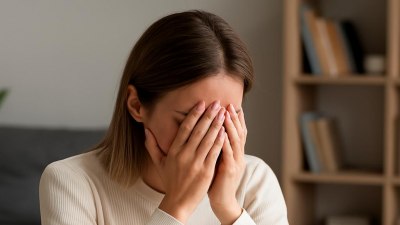Tried and Tested: 5 Grounding Techniques That Actually Helped Me During Anxiety (And Might Help You Too)
After doing some research and testing different techniques, I found a few that truly help me

This image was created with the assistance of DALL·E
Let’s start with some clarification about the word anxious. It’s that feeling of fear or unease. But here’s the thing—feeling anxious is actually a good thing. It’s our body’s way of responding to potential threats or danger. Anxiety helps us focus and react quickly when needed. So, keep in mind that anxiety is perfectly normal, and take a moment to appreciate that your body is working hard to protect you and keep you safe.
However, sometimes anxiety can become severe and overwhelming, lasting longer than it should. This is when we start talking about anxiety disorders. According to World Health Organisation there are several different kinds of anxiety disorders, including:
- generalized anxiety disorder (persistent and excessive worry about daily activities or events);
- panic disorder (panic attacks and fear of continued panic attacks);
- social anxiety disorder (high levels of fear and worry about social situations that might make the person feel humiliated, embarrassed or rejected);
- agoraphobia (excessive fear, worry and avoidance of situations that might cause a person to panic or feel trapped, helpless or embarrassed);
- separation anxiety disorder (excessive fear or worry about being separated from people with whom the person has a deep emotional bond);
- specific phobias (intense, irrational fears of specific objects or situations that lead to avoidance behaviour and significant distress); and
- selective mutism (consistent inability to speak in certain social situations, despite the ability to speak comfortably in other settings, primarily affecting children).
Some of the symptoms of anxiety may include:
- trouble concentrating or making decisions
- feeling irritable, tense or restless
- experiencing nausea or abdominal distress
- having heart palpitations
- sweating, trembling or shaking
- trouble sleeping
- having a sense of impending danger, panic or doom.
If you think you might be suffering from an anxiety disorder, please seek professional help.
Now, let’s move on to some simple techniques you can use to manage anxious thoughts. Mental health professionals use different approaches to treat anxiety—they might recommend cognitive behavioral therapy, cutting down on caffeine and alcohol, breathing exercises, or even medication. That’s for specialists to decide.
Today, I want to share something that has worked really well for me—grounding techniques.
Why Grounding?
First, let me tell you what happens to me when anxiety creeps in.
My mind just won’t stop thinking about the problem, no matter how hard I try to convince myself that everything is okay. My face gets red, I start emotional eating (which doesn’t help), then I call someone to talk about the problem (which also doesn’t help), and then I start analyzing it to death—until it grows bigger in my head and suddenly everything feels hopeless. That’s when I start panicking, eating again, and manically trying to solve the problem—which, in most cases, is a huge mistake because people don’t make the best decisions in anxious moments.
That’s when I decided to try grounding. I had heard about it before but never really took it seriously. After doing some research and testing different techniques, I found a few that truly help me.
1. The 5-4-3-2-1 Method
This is a simple coping exercise that shifts your focus from anxious thoughts to your surroundings.
🔹 Name 5 things you can see around you
🔹 Name 4 things you can touch
🔹 Name 3 things you can hear
🔹 Name 2 things you can smell
🔹 Name 1 thing you can taste
To be honest, I always forget the exact order, so I improvise—sometimes I name five things I see, but only two things I hear, and it still works! The key is to shift your attention away from the anxious thoughts.
2. The "Name Everything Around You" Technique
This one is even simpler than the 5-4-3-2-1 method. Just start naming everything you see:
"This is a table. This is a window. This is my water bottle. This is a chair. This is a bed. This is a door."
The more you describe your surroundings, the more your mind moves away from the anxiety loop.
3. The Feet-on-the-Floor Technique
This is one of the simplest and fastest grounding techniques.
✔️ Sit down and place both feet flat on the floor.
✔️ Focus on the sensation—how does the ground feel?
✔️ Press your feet down a little harder.
✔️ Feel the connection to the floor, and remind yourself: I am here. I am safe.
This technique helps bring you back to the present moment, especially if you feel lightheaded or disconnected.
4. Mental Distraction Games
These are small exercises to keep your mind busy when it just won’t stop overthinking. Try these:
✔️ Count backward from 100 to 1
✔️ Recite a song or poem you know by heart
✔️ Think of three things for every letter of your name
✔️ Play the alphabet game—pick a category (e.g., animals, cities, foods) and name one for each letter (A - Apple, B - Banana, C - Carrot…)
✔️ Make a grocery list (Yes, this actually helps! 😄)
✔️ Write with your opposite hand, or even eat with your opposite hand—it forces your brain to focus on the task
✔️ Get creative—draw, write, play music, work, if you have to, anything to shift your thoughts
5. Move Your Body
Physical movement is one of the best ways to break free from an anxious spiral.
✔️ Go for a walk or run
✔️ Go to the gym
✔️ Do some crunches or push-ups
✔️ Dance to your favorite song
✔️ Stretch, do yoga, or shake out the tension
I’ve tried this many times, and I can confirm—it helps a lot!
Bonus Tip: Gratitude
I believe so much in gratitude that I plan to write a whole article on it. But for now, here’s something simple:
✔️ Write down 5 things you are grateful for in life—the amazing nature, the starry sky, the sun, which keeps you warm and happy, etc.
✔️ Write down 5 things from your day that you are grateful for—the cashier who smiled at you and wished you an amazing day, the phone call from your mom, your boyfriend who told you he loved you this morning, your friend who laughed with you over a stupid joke for half an hour. And even if you spent the day alone, you can still be grateful—for the peaceful time you had, for the movie you watched, for the food you ate. There is something to be grateful for EVERY SINGLE DAY—you just have to start looking for it, and soon, those moments will start finding you.
✔️ Thank someone. Right now, don’t overthink it. Call your dad and thank him, send your best friend an SMS, and if you don’t feel like thanking anyone right now—thank yourself: I thank myself for being brave. I thank myself for becoming stronger after this anxiety attack. I thank myself for being a good person.
So, this is my advice, based on what has helped me. I hope this information is useful to you too. Keep in mind that this content is based on personal experiences, research, and general knowledge. It is intended for informational and educational purposes only and should not be considered professional medical, psychological, or therapeutic advice. If you are facing mental health challenges or any other serious concerns, please seek support from a qualified professional.




